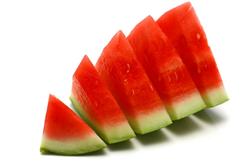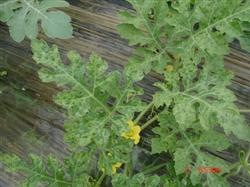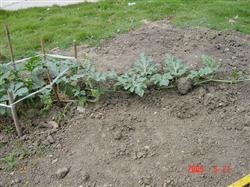Cultivation and control techniques of main diseases and insect pests of watermelon

Watermelon is a popular summer-relieving fruit, but diseases and insect pests occur frequently in production, especially diseases. Attaching importance to fitness cultivation can effectively control and reduce the harm of diseases and insect pests. 1) cultivation techniques 1) selection and preparation of land. Watermelon drought tolerance, fear of waterlogging, avoid continuous cropping, land selection should be well-ventilated fertile sandy loam is appropriate, generally do not choose continuous watermelon cultivation of Lei Feng. Soil preparation should be deep ploughing, border ditch, waist ditch, perimeter ditch three ditches are connected, in order to facilitate drainage and irrigation. 2) Fei Shui Pan Li. Applying sufficient base fertilizer and reasonable topdressing requires the premise of high yield and high quality of watermelon. The base fertilizer accounts for about 60% to 70% of the total amount, and the best application method is light application or hole application, mainly organic fertilizer, 100kg of cake fertilizer per 667m2, 50kg of bone meal (such as lack of cake fertilizer and bone meal can be used as ternary compound fertilizer 5080kg), 2000 kg of barnyard manure and 2000kg / 3000kg of high quality compost. Topdressing depends on the growth period of watermelon. After the watermelon is planted and survived, it is necessary to apply seedling fertilizer, that is, 10kg / 667m2 of ternary compound fertilizer in ditch or hole, 10kg / 667m2 of ternary compound fertilizer in ditch or hole, 10kg / 667m2 of ternary compound fertilizer in ditch or hole, and 1000 kg of manure or 40kg of ternary compound fertilizer in ditch or hole every 667m2. In the later stage of watermelon growth, combined with pest control, external root topdressing (0.3% potassium dihydrogen phosphate + 0.3% urea aqueous solution or foliar fertilizer such as foliar fertilizer) can protect leaves and increase yield. (2) Prevention and control of watermelon main diseases 2.1 the main pathogen of watermelon Fusarium wilt is soil, and the pathogen in soil can survive for 5 years for 7 years. Control measures: 1) rotation. Work in office buildings for more than 3 years with non-melon crops. 2) grafting. Rootstock to round gourd, long gourd, ladle gourd, waist gourd performance is better. The method of insertion and connection is simple and easy. When the bottle gourd sprouts and dew tip, the watermelon is planted, and the rootstock has two leaves in one heart (the second leaf unfolds and the third true leaf grows). When grafting, first erase the growing point of the rootstock with a bamboo cutting, then use the tip of the bamboo cutting to insert a small hole vertically from the growing point (about 1 cm deep), then take the watermelon seedlings, close and squeeze the cotyledons, cut into a wedge-shaped surface on the Hypocotyl about 1 cm below the cotyledons with a knife, and the section is about 0.8 cm long. after the sap flow is finished, it is inserted into the hole of the rootstock and the grafting is completed. Finally, cover the film to moisturize. 3) Pesticide control. In the initial stage of the disease or when the melon vine grows to 50 cm, the root is irrigated with 500 × 800 times liquid such as 40% carbendazim glue or 25.9% complexing ammonia, copper and zinc water agent (Kangkuling), once every 7 days and 3 times continuously. Nematodes should be added to root irrigation in nematode-prone areas. 4) select disease-resistant (tolerant) varieties. Zhengkang No. 1, No. 2, Zhong 8602F and Jingxin No. 1 were more resistant (resistant) to the disease. 2.2 Watermelon anthracnose is mainly caused by soil and seed epidermis, which is spread and invaded by running water and wounds. Prevention and control measures: 1) Deep ditches and high beds to prevent stagnant water, it is stated that grass is laid under the ground, so that watermelons do not touch the ground directly. 2) seed treatment. Soak seeds with 15min at 55 degrees Celsius or 30min with 100x formaldehyde solution, rinse with clean water and sow seeds. 3) Pesticide control. Choose 405 carbendazim suspension or 70% chlorothalonil wettable powder or 25% carbendazim wettable powder 600 times 700 times liquid spray at the initial stage of the disease. Take precautions once every 7 to 10 days, even for about 3 times. 2.3The bacterial corner spot of watermelon was mainly carried by soil and seeds, and was transmitted by Rain Water. Control measures: 1) seed treatment (same as watermelon anthracnose). 2) Pesticide control. At the initial stage of the disease, 72% agricultural streptomycin 250mg/ kg or 40% nail cream copper wettable powder 500x solution or neophytomycin 200mg/ kg spray were used. (3) the main harm of watermelon pests to control watermelon pests is that melon aphids suck the leaves; the adults of Liriomyza sinensis stab the leaves and lay eggs, and the larvae latent feed on the leaves; the palm thrips file sucks the juices of tender shoots, tender leaves, flowers and young melons; the adults of Huangshou melon eat leaves, tender stems, flower organs and young melons, and the larvae damage the roots; leaf mite adults and nymphs all suck juice on the back of leaves. Control measures: 1) plastic film covering to avoid aphids (film width 70% to 100 cm). 2) Pesticide control. Spray 1.8% avermectin EC 3000 times or 20% fenvalerate EC 2000 times to control adults of Huangshou melon, American zebra fly, palm thrips, etc.; spray 1500 times of imidacloprid wettable powder to control melon aphid, whitefly, etc.; irrigate roots with 1000 times of 80% trichlorfon soluble powder to control Huangshou melon larvae and underground pests; use propargite 73% EC 20003000x leaf spray to control red leaf mites.
- Prev

Watermelon should pay attention to prevent the harm of new virus
A quarantine virus disease, cucumber green mottle mosaic virus, has been discovered. It is necessary to pay attention to prevention, but it is not necessary to pull it out and replant regardless of the reason. Here, let's introduce this new viral disease. Cucumber green mottle mosaic virus has a narrow host range, which mainly occurs in yellow.
- Next

Technology of pressing vine and pruning of watermelon
Vine pressing and pruning are the main technical links in watermelon cultivation and management. through vine pressing and pruning, land and light energy can be effectively used to regulate and inhibit the growth and distribution of watermelon stems, so as to improve the quality and yield of watermelon. 1. Invert seedlings and cultivate soil in the rhizosphere before pressing the vine. 6 true leaves appeared in the seedling and began to be smoked.
Related
- Moge, come on! The staff of the peasant association in the producing area of cantaloupe were frightened when the crowd gathered.
- Causes and Solutions of low Fruit setting rate of Apple
- Symptoms and control measures of passion fruit virus disease
- Fruit growing lesson: how do apple orchards keep high yields?
- Can you build orchards in the mountains? What are the pros and cons?
- How to manage the coloring period of Crisson grape?
- This paper introduces the processing technology of two kinds of fig products.
- How much is a month for retired teachers in rural areas by 2020?
- How can strawberry planting increase sugar content? We should pay attention to management in many aspects.
- What are the cultivation techniques on how to improve the yield of golden fruit?

